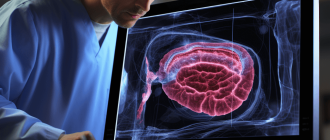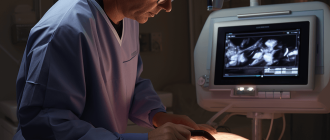 Testing and Procedures for Diagnosing Stomach and Duodenal Ulcers: A Comprehensive Guide
Testing and Procedures for Diagnosing Stomach and Duodenal Ulcers: A Comprehensive Guide
Stomach and duodenal ulcers are open sores that develop on the lining of the stomach or the upper part of the small intestine, known as the duodenum. These ulcers can cause a range of symptoms, including abdominal pain, bloating, and nausea. To properly diagnose ulcers and determine the most effective treatment, doctors may recommend several tests and procedures.
One common test for diagnosing ulcers is an upper endoscopy, also known as an esophagogastroduodenoscopy (EGD). During this procedure, a thin, flexible tube with a camera on the end is inserted through the mouth and into the esophagus, stomach, and duodenum. This allows the doctor to visually examine the lining of these organs and identify any ulcers or other abnormalities.
In addition to an upper endoscopy, doctors may also perform a test called a biopsy. During a biopsy, a small sample of tissue is taken from the stomach or duodenum to be examined under a microscope. This can help confirm the presence of an ulcer and rule out other conditions.
Another test commonly used to diagnose ulcers is a breath test. This test involves drinking a solution containing a substance called urea. If there is an ulcer present, certain bacteria in the stomach can break down the urea and release carbon dioxide, which can be detected in the breath. This test is non-invasive and can provide quick results.
In some cases, doctors may also recommend a blood test to check for the presence of antibodies to a bacteria called Helicobacter pylori. This bacteria is a common cause of stomach and duodenal ulcers. If antibodies are detected, it may indicate an active infection that requires treatment with antibiotics.
Overall, diagnosing stomach and duodenal ulcers involves a combination of tests and procedures to accurately identify the presence of ulcers and determine the most appropriate treatment plan. These tests are safe, effective, and can provide valuable information to help manage and alleviate ulcer-related symptoms.
Can a duodenal ulcer be seen in an endoscopy?
Yes, a duodenal ulcer can be seen during an endoscopy, which is a procedure that allows a doctor to examine the lining of the esophagus, stomach, and duodenum. During an endoscopy, a thin, flexible tube with a light and camera on the end, called an endoscope, is inserted through the mouth and into the digestive tract.
The endoscope allows the doctor to visualize the inside of the duodenum and identify any abnormalities, including duodenal ulcers. The camera on the endoscope provides real-time images, allowing the doctor to carefully examine the area and determine the presence and severity of any ulcers.
If a duodenal ulcer is found during the endoscopy, the doctor may take a biopsy, which involves removing a small sample of tissue for further examination. This can help confirm the diagnosis and rule out other conditions that may have similar symptoms.
In addition to visualizing the ulcer, an endoscopy can also help determine the cause of the ulcer. Common causes of duodenal ulcers include infection with the bacteria Helicobacter pylori or the use of nonsteroidal anti-inflammatory drugs (NSAIDs). By identifying the cause, the doctor can develop an appropriate treatment plan to address the underlying issue and promote healing of the ulcer.
Overall, an endoscopy is a valuable tool for diagnosing duodenal ulcers and guiding treatment decisions. It allows doctors to directly visualize the ulcer and gather important information about its severity and underlying cause.
Yes, endoscopy allows direct visualization of duodenal ulcers
Endoscopy is a commonly used procedure to diagnose stomach and duodenal ulcers. It involves the use of a thin, flexible tube with a light and a camera, called an endoscope, which is inserted through the mouth and into the digestive tract. This allows doctors to directly visualize the lining of the stomach and duodenum, and identify any abnormalities or ulcers.
During the endoscopy, the patient is usually sedated to minimize discomfort. The endoscope is carefully maneuvered through the esophagus and into the stomach and duodenum. The camera on the endoscope captures real-time images, which are displayed on a monitor for the doctor to examine.
If a duodenal ulcer is present, it will be clearly visible during the endoscopy. The doctor can assess the size, location, and severity of the ulcer, as well as any associated complications, such as bleeding or infection. Biopsy samples can also be taken during the procedure for further analysis.
Endoscopy is considered the gold standard for diagnosing duodenal ulcers because it provides direct visualization of the ulcer and allows for the collection of tissue samples. This procedure is safe and generally well-tolerated by patients. It is an important tool in the diagnosis and management of stomach and duodenal ulcers.
Endoscopy is an effective and reliable method for directly visualizing duodenal ulcers. It allows doctors to accurately diagnose and assess the ulcers, as well as identify any associated complications. If you suspect you have a duodenal ulcer, talk to your doctor about the possibility of undergoing an endoscopy.
Can ultrasound detect stomach ulcer?
Ultrasound, also known as sonography, is a non-invasive imaging technique that uses sound waves to create images of the body’s internal structures. While it is commonly used to visualize organs such as the liver, gallbladder, and kidneys, it is not typically used as a primary tool for diagnosing stomach ulcers.
Stomach ulcers, also known as gastric ulcers, are open sores that develop on the inner lining of the stomach. They are usually caused by a bacterial infection called Helicobacter pylori or long-term use of nonsteroidal anti-inflammatory drugs (NSAIDs). The most common symptoms of stomach ulcers include abdominal pain, bloating, heartburn, and nausea.
While ultrasound can detect certain abnormalities in the stomach, such as thickening of the stomach wall or changes in the surrounding organs, it is not as accurate or specific in diagnosing stomach ulcers compared to other diagnostic tests. Endoscopy and imaging techniques like computed tomography (CT) scan or barium swallow study are typically used to confirm the presence of a stomach ulcer.
During an endoscopy, a flexible tube with a light and camera at the end is inserted through the mouth and into the stomach. This allows the doctor to directly visualize the stomach lining and take a biopsy if necessary. A CT scan or barium swallow study can provide more detailed images of the stomach and help identify the presence of an ulcer.
In some cases, ultrasound may be used as a complementary tool to assess the surrounding organs and rule out other causes of abdominal pain. However, it is not the primary method used to diagnose stomach ulcers.
If you are experiencing symptoms of a stomach ulcer, it is important to consult your healthcare provider. They will be able to recommend the appropriate diagnostic tests and procedures to accurately diagnose and treat your condition.
No, ultrasound is not typically used to diagnose ulcers
Ultrasound is a diagnostic imaging technique that uses sound waves to create images of the internal organs. While it is commonly used to diagnose various conditions, it is not typically used to diagnose stomach and duodenal ulcers.
Stomach and duodenal ulcers are usually diagnosed using other methods, such as:
- Upper endoscopy: This procedure involves inserting a thin, flexible tube with a camera into the mouth and down the throat to examine the esophagus, stomach, and duodenum. During the procedure, the doctor can visually inspect the lining of these organs and take biopsies if necessary.
- X-ray with barium swallow: This test involves drinking a liquid containing barium, which coats the lining of the esophagus, stomach, and duodenum. X-rays are then taken to visualize any abnormalities, such as ulcers.
- Stool test for H. pylori: Helicobacter pylori (H. pylori) is a bacterium that can cause stomach and duodenal ulcers. A stool test can determine if H. pylori is present in the digestive system.
- Blood test: A blood test can be done to check for the presence of H. pylori antibodies, which can indicate an infection.
If ulcers are suspected, it is important to consult a healthcare provider for proper diagnosis and treatment. They can recommend the most appropriate tests and procedures based on the individual’s symptoms and medical history.
What are the red flags for stomach ulcers?
Stomach ulcers, also known as gastric ulcers, are open sores that develop on the lining of the stomach. They can cause a range of symptoms, some of which may be red flags indicating a more serious condition. If you experience any of the following symptoms, it is important to seek medical attention:
- Severe or persistent abdominal pain
- Bloody or black stools
- Vomiting blood or coffee ground-like material
- Unexplained weight loss
- Difficulty swallowing
- Loss of appetite
- Nausea or vomiting
- Feeling full after eating only a small amount
- Extreme fatigue or weakness
- Pale skin
- Shortness of breath
- Rapid heart rate
If you experience any of these red flag symptoms, it is important to see a healthcare professional as soon as possible. They can help diagnose the cause of your symptoms and recommend appropriate treatment.
Vomiting blood
Vomiting blood, also known as hematemesis, is a serious symptom that requires immediate medical attention. It is characterized by the presence of blood in vomit.
There are several possible causes of vomiting blood, including:
- Gastric ulcers: These are open sores that develop on the lining of the stomach. If they bleed, it can result in vomiting blood.
- Esophageal varices: These are enlarged veins in the esophagus that can rupture and cause bleeding.
- Mallory-Weiss tear: This is a tear in the lining of the esophagus or stomach, often caused by severe vomiting.
- Gastroesophageal reflux disease (GERD): Severe and chronic acid reflux can cause irritation and ulceration of the esophagus, leading to vomiting blood.
- Gastritis: Inflammation of the stomach lining can cause bleeding and subsequent vomiting of blood.
If you experience vomiting blood, it is important to seek medical help immediately. Your doctor will likely perform diagnostic tests, such as an endoscopy or upper gastrointestinal series, to determine the cause of the bleeding.
Treatment for vomiting blood depends on the underlying cause. It may involve medication to reduce stomach acid, antibiotics to treat infections, or surgery to repair any tears or ulcers.
Vomiting blood is a serious symptom that should never be ignored. If you or someone you know experiences this symptom, it is crucial to seek medical attention right away to identify and treat the underlying cause.
Passing black stools
If you are experiencing black, tarry stools, it could be an indication of bleeding in the upper gastrointestinal tract. This can be a symptom of a stomach or duodenal ulcer. The dark color of the stool is caused by the presence of digested blood.
It is important to seek medical attention if you are passing black stools, as it may indicate a serious condition. Your doctor will likely perform a physical examination and order tests to determine the cause of the bleeding.
Tests that may be used to diagnose the source of the bleeding include:
| Endoscopy: | A thin, flexible tube with a camera at the end is inserted through the mouth and into the digestive tract to visually examine the upper gastrointestinal tract. |
| Blood tests: | These tests can check for signs of anemia or infection, which may be associated with bleeding. |
| Stool tests: | These tests can detect the presence of blood in the stool, which may help identify the source of the bleeding. |
| Imaging tests: | Tests such as X-rays or CT scans may be used to visualize the gastrointestinal tract and identify any abnormalities. |
Treatment for black stools will depend on the underlying cause. This may involve medications to reduce stomach acid and promote healing of ulcers, as well as lifestyle changes to reduce risk factors such as smoking and excessive alcohol consumption.
In some cases, surgery may be necessary to treat the bleeding or remove the ulcer. Your doctor will discuss the best treatment options for your specific situation.
Losing weight
Losing weight can be an important part of managing stomach and duodenal ulcers. Excess weight can put pressure on the stomach and increase the risk of developing ulcers or worsening existing ones. Additionally, losing weight can help reduce inflammation in the digestive system and improve overall health.
Here are some tips for losing weight if you have stomach or duodenal ulcers:
- Eat a balanced diet: Focus on consuming a variety of fruits, vegetables, whole grains, and lean proteins. Avoid foods that are high in fat, sugar, and processed ingredients.
- Control portion sizes: Be mindful of how much you eat. Use smaller plates and bowls to help control portion sizes and prevent overeating.
- Avoid trigger foods: Certain foods, such as spicy foods, citrus fruits, and caffeine, can irritate the stomach and worsen ulcer symptoms. Avoid these trigger foods to help manage your condition.
- Stay hydrated: Drink plenty of water throughout the day to help maintain a healthy weight and support digestion.
- Engage in regular physical activity: Incorporate exercise into your daily routine to help burn calories and maintain a healthy weight. Consult with your healthcare provider before starting any new exercise program.
- Manage stress: Stress can worsen ulcer symptoms and contribute to weight gain. Practice stress-reducing techniques, such as deep breathing exercises, meditation, or yoga.
Remember, it’s important to consult with your healthcare provider before making any significant changes to your diet or exercise routine. They can provide personalized recommendations based on your individual needs and medical history.
Feeling full after eating little
Feeling full after eating only a small amount of food can be a symptom of stomach and duodenal ulcers. These ulcers are open sores that develop on the lining of the stomach or the upper part of the small intestine, called the duodenum.
When you have an ulcer, the lining of your stomach or duodenum becomes damaged, leading to pain and discomfort. One common symptom of ulcers is feeling full quickly, even after eating a small portion of food. This is known as early satiety.
There are several reasons why you may experience this feeling. First, the ulcer itself can cause inflammation and irritation, which can affect your digestion. The presence of the ulcer can also trigger increased production of stomach acid, which can lead to feelings of fullness.
In addition to feeling full after eating little, other symptoms of stomach and duodenal ulcers may include:
- Abdominal pain or discomfort
- Heartburn or acid reflux
- Nausea or vomiting
- Loss of appetite
- Unintentional weight loss
If you are experiencing these symptoms, it is important to see a doctor for a proper diagnosis. They may recommend tests such as an endoscopy, where a small camera is used to examine the lining of your stomach and duodenum, or a breath test to check for the presence of a bacterial infection called Helicobacter pylori, which is commonly associated with ulcers.
Treatment for stomach and duodenal ulcers may include medications to reduce stomach acid, antibiotics to treat an H. pylori infection, and lifestyle changes such as avoiding certain foods and managing stress. By seeking prompt medical attention and following your doctor’s recommendations, you can manage your symptoms and prevent complications from ulcers.
Can duodenal ulcer be cured permanently?
Yes, duodenal ulcers can be cured permanently with proper treatment and lifestyle changes. The primary goal of treatment is to heal the ulcer and prevent its recurrence.
Treatment options for duodenal ulcers may include:
- Medications: The use of proton pump inhibitors (PPIs), such as omeprazole or lansoprazole, can help reduce stomach acid production and promote healing of the ulcer. Antibiotics may also be prescribed if the ulcer is caused by an infection with Helicobacter pylori.
- Lifestyle modifications: Making certain changes in lifestyle can help prevent the recurrence of duodenal ulcers. This may include avoiding alcohol and smoking, managing stress levels, and avoiding nonsteroidal anti-inflammatory drugs (NSAIDs) if possible.
- Dietary changes: Following a healthy diet that includes foods rich in fiber, such as fruits, vegetables, and whole grains, can help promote healing and prevent future ulcers. It is also important to avoid spicy and acidic foods that may irritate the stomach lining.
It is essential to complete the full course of treatment as prescribed by a healthcare professional to ensure the complete healing of the duodenal ulcer. Regular follow-up appointments may also be necessary to monitor the progress and make any necessary adjustments to the treatment plan.
If left untreated or not properly managed, duodenal ulcers can lead to complications such as bleeding, perforation, or obstruction. Therefore, seeking timely medical attention and adhering to the recommended treatment plan can greatly increase the chances of curing the ulcer permanently.
Yes, duodenal ulcers can be fully cured with proper treatment
Diagnosing and treating duodenal ulcers is crucial to ensure a full recovery. With the right approach, duodenal ulcers can be cured completely.
When diagnosing a duodenal ulcer, your doctor may perform several tests and procedures to confirm the presence of the ulcer and determine its severity. These tests may include:
| 1. Upper Endoscopy: | A thin, flexible tube with a camera is inserted through the mouth to examine the esophagus, stomach, and duodenum. This allows the doctor to directly visualize the ulcer and take biopsies if needed. |
| 2. Upper GI Series: | A series of X-rays are taken after drinking a contrast solution that coats the digestive organs. This helps identify any abnormalities in the esophagus, stomach, or duodenum. |
| 3. Stool Test: | A sample of stool may be tested for the presence of Helicobacter pylori, a bacterium that can cause duodenal ulcers. |
Once a duodenal ulcer is diagnosed, treatment can begin. The main goals of treatment are to relieve symptoms, promote healing, and prevent complications. Treatment options may include:
1. Medications:
Proton pump inhibitors (PPIs) are commonly prescribed to reduce stomach acid and promote healing. Antibiotics may also be prescribed if Helicobacter pylori is present.
2. Lifestyle Changes:
Avoiding certain foods and beverages that can irritate the stomach, quitting smoking, and reducing stress can help improve symptoms and prevent future ulcers.
3. Surgery:
In rare cases where medications and lifestyle changes are not effective, surgery may be necessary to remove the ulcer or repair any complications.
With the appropriate treatment and adherence to lifestyle changes, most duodenal ulcers can be fully cured. It is important to follow your doctor’s recommendations and attend regular follow-up appointments to monitor your progress.
What is the most reliable symptom of duodenal ulcer?
The most reliable symptom of a duodenal ulcer is abdominal pain. This pain is typically described as a burning or gnawing sensation that is located in the upper abdomen, just below the breastbone. The pain may come and go, and it is often relieved by eating or taking antacids.
In some cases, the pain may be severe and can wake you up at night. It may also be accompanied by other symptoms such as bloating, nausea, vomiting, and a feeling of fullness. These symptoms can vary in intensity and may worsen or improve over time.
It is important to note that not all people with duodenal ulcers will experience symptoms. Some individuals may have what is known as a silent ulcer, which means they have an ulcer but do not have any symptoms. In these cases, the ulcer may only be detected during tests or procedures performed for other reasons.
If you are experiencing any of the symptoms mentioned above, it is important to see a healthcare provider for an accurate diagnosis and appropriate treatment. Other conditions, such as gastroesophageal reflux disease (GERD) or gastritis, can cause similar symptoms, so it is important to rule out other possible causes.
Abdominal pain relieved by eating
Abdominal pain that is relieved by eating is a common symptom of stomach and duodenal ulcers. This type of pain is known as “hunger pain” and is typically felt in the upper abdomen.
When a person with an ulcer eats food, it helps to neutralize the stomach acid, temporarily relieving the pain. However, the pain will often return a few hours after eating, once the stomach acid levels increase again.
It is important to note that not all abdominal pain relieved by eating is necessarily due to ulcers. Other conditions, such as gastritis or gallbladder disease, can also cause similar symptoms. Therefore, it is essential to see a healthcare provider for a proper diagnosis.
During a medical evaluation for abdominal pain relieved by eating, the healthcare provider may perform various tests and procedures, including:
- A physical examination to assess the abdomen for tenderness or swelling
- Blood tests to check for infection or other abnormalities
- An upper endoscopy to visualize the stomach and duodenum and obtain tissue samples for further analysis
- A barium swallow or upper gastrointestinal series to evaluate the structures of the upper digestive tract
- A stool test to check for the presence of blood or other abnormalities
These tests can help determine the underlying cause of the abdominal pain and guide the appropriate treatment plan.
Abdominal pain relieved by eating can be a symptom of stomach and duodenal ulcers. It is important to seek medical attention for proper diagnosis and treatment.
How can MALS be differentiated from an ulcer in diagnosis?
Median Arcuate Ligament Syndrome (MALS) and stomach or duodenal ulcers can have similar symptoms, making it important to differentiate between the two in the diagnosis process. Here are some ways in which MALS can be differentiated from an ulcer:
- Physical examination: A physical examination by a healthcare provider can help identify certain signs that may indicate MALS, such as abdominal tenderness or a pulsatile mass in the upper abdomen.
- Imaging tests: Imaging tests such as ultrasound, computed tomography (CT) scan, magnetic resonance imaging (MRI), or angiography can be used to visualize the blood vessels and identify any abnormalities or compression of the celiac artery, which is a characteristic feature of MALS.
- Endoscopy: Endoscopy involves inserting a flexible tube with a camera into the digestive tract to examine the stomach and duodenum. This procedure can help identify any ulcers or abnormalities in the lining of the digestive tract.
- Diagnostic laparoscopy: In some cases, a diagnostic laparoscopy may be performed to directly visualize the celiac artery and surrounding structures. This minimally invasive procedure allows for a more accurate diagnosis of MALS.
- Response to treatment: MALS is typically treated with surgical intervention, such as a procedure called celiac artery decompression. If symptoms improve or resolve after the surgery, it may indicate that the underlying cause was MALS rather than an ulcer.
It is important to consult with a healthcare professional for a proper diagnosis and to rule out other potential causes of the symptoms. Only a qualified healthcare provider can accurately differentiate between MALS and an ulcer based on a thorough evaluation of the individual’s medical history, symptoms, and diagnostic test results.
Imaging tests like CT scan can distinguish MALS from ulcers
When diagnosing stomach and duodenal ulcers, it is important to rule out other potential causes of similar symptoms. One condition that can mimic the symptoms of ulcers is median arcuate ligament syndrome (MALS). MALS is a rare disorder that occurs when the median arcuate ligament, a band of tissue that supports the diaphragm, compresses the celiac artery.
To differentiate between MALS and ulcers, imaging tests such as a CT scan can be used. A CT scan can provide detailed images of the abdominal area, allowing doctors to visualize any compression or blockage of the celiac artery caused by the median arcuate ligament. This can help determine whether the symptoms are due to MALS or ulcers.
In addition to a CT scan, other imaging tests like magnetic resonance angiography (MRA) and Doppler ultrasound can also be used to evaluate blood flow to the abdominal organs and identify any abnormalities or vascular compression.
By utilizing these imaging tests, healthcare professionals can accurately diagnose MALS and differentiate it from ulcers. This is crucial for developing an appropriate treatment plan and ensuring that patients receive the most effective care.
Q&A:
What are the symptoms of stomach and duodenal ulcers?
The symptoms of stomach and duodenal ulcers can vary, but common signs include abdominal pain, bloating, nausea, vomiting, and loss of appetite.
How are stomach and duodenal ulcers diagnosed?
Stomach and duodenal ulcers can be diagnosed through a combination of medical history, physical examination, and tests such as endoscopy, X-rays, and blood tests.
What is an endoscopy?
An endoscopy is a procedure in which a thin, flexible tube with a camera is inserted into the digestive tract to visually examine the lining of the stomach and duodenum. It can help diagnose ulcers and other gastrointestinal conditions.
Are there any risks or complications associated with endoscopy?
While endoscopy is generally considered safe, there are potential risks and complications such as bleeding, infection, and perforation of the digestive tract. These risks are rare, but it’s important to discuss them with your healthcare provider before the procedure.
Can a blood test detect stomach and duodenal ulcers?
A blood test can help detect certain infections, such as Helicobacter pylori, which is a common cause of stomach and duodenal ulcers. However, blood tests alone are not sufficient to diagnose ulcers and other tests may be needed for a conclusive diagnosis.
What are the symptoms of stomach and duodenal ulcers?
The symptoms of stomach and duodenal ulcers can vary, but common symptoms may include abdominal pain, bloating, nausea, vomiting, weight loss, and appetite changes.
How are stomach and duodenal ulcers diagnosed?
Stomach and duodenal ulcers can be diagnosed through various tests and procedures such as endoscopy, blood tests, stool tests, and imaging tests like X-rays or CT scans.






